David S Cronan* examines the ‘then and now’ of mineral prospects on the deep ocean bed.
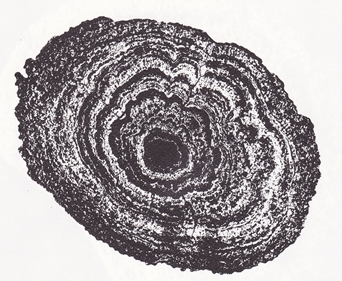 The year 2015 is important for deep sea minerals as it marks the 50th anniversary of the publication of The Mineral Resources of the Sea1 by John L Mero Jr (1929-2001) - arguably the work that kick-started the whole deep sea minerals business.
The year 2015 is important for deep sea minerals as it marks the 50th anniversary of the publication of The Mineral Resources of the Sea1 by John L Mero Jr (1929-2001) - arguably the work that kick-started the whole deep sea minerals business.
Left: Cross section of a polymetallic nodule showing characteristic concentric banding (light bands are Mn rich, dark bands are Fe rich). Reproduced by kind permission of CNEXO, France.
Mero was not the first to recognise their potential. In a letter to his father in the 1870s, John Young Buchanan (1844-1925), ship´s chemist on Challenger (1873-1876) commented on the possible future value of manganese nodules, which that expedition recovered2. In the early 1960s, Sir Kingsley Dunham FRS (1910-2001), drew attention to the possibility of potentially economic hydrothermal minerals forming on the seafloor, several years before they were actually discovered3.
Initial enthusiasm
This commenced around the time of publication of John Mero's book in 1965, and lasted more or less until the conclusion of the Law of the Sea Convention in 1982. The main minerals of interest at that time were polymetallic (formerly ‘manganese’) nodules. It was not until the work of Mero that any serious consideration was given to mining them. Mero considered that if only 10% of the nodule deposits on the ocean floor were to be mined, sufficient supplies of many metals would last thousands of years at the then rate of consumption. He also said that the nodules were growing at a faster rate than the metals they contained were being consumed, which globally is true. However, subsequent work has shown that only a small proportion of nodules will be mineable, and that these are among the slowest growing. These nodules do not grow faster than they could be mined.
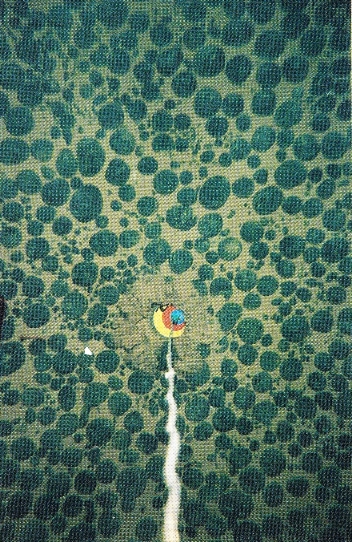 Another oft-quoted point that Mero made was that marine mining could lead to the closure of environmentally polluting land mines - a point that has been made in regard to nodule mining versus nickeliferous laterite mining, which is a great despoiler of mainly tropical areas. These points have been more recently amplified by Heydon4 who stated that ‘in contrast to terrestrial mining, deep-sea mineral extraction involves minimal overburden stripping…decreased extraction waste, no social displacement, minimal production infrastructure and no need to build roads and railway lines for haulage from mine site, no drill blasting, no acid mine drainage, no deforestation, and in the case of polymetallic nodules lends itself to clean mineral processing solutions that can result in benign and saleable tailings’. However, Mero seemed never to have considered the possibility of marine environmental damage - something now at the forefront of debate5.
Another oft-quoted point that Mero made was that marine mining could lead to the closure of environmentally polluting land mines - a point that has been made in regard to nodule mining versus nickeliferous laterite mining, which is a great despoiler of mainly tropical areas. These points have been more recently amplified by Heydon4 who stated that ‘in contrast to terrestrial mining, deep-sea mineral extraction involves minimal overburden stripping…decreased extraction waste, no social displacement, minimal production infrastructure and no need to build roads and railway lines for haulage from mine site, no drill blasting, no acid mine drainage, no deforestation, and in the case of polymetallic nodules lends itself to clean mineral processing solutions that can result in benign and saleable tailings’. However, Mero seemed never to have considered the possibility of marine environmental damage - something now at the forefront of debate5.
Right: Photograph of polymetallic nodules on the sea floor in the Pacific Ocean taken with a camera attached to a sampling grab" (the multicoloured trigger weight for the camera is 8cm in diameter).
Commercial interest commenced in the mid-1960s and by the end of the 1970s several consortia had been formed to mine in the Clarion-Clipperton Zone (CCZ), a large area in the NE tropical Pacific <Fig 1>. From the early 1960s up to about 1984, large sums were spent by industrial consortia exploring, evaluating and claiming future mine sites in the CCZ, but most are now inactive. Towards the end of ‘ initial enthusiasm’ and later, a number of National Consortia were formed for nodule mining, most of which are still active.
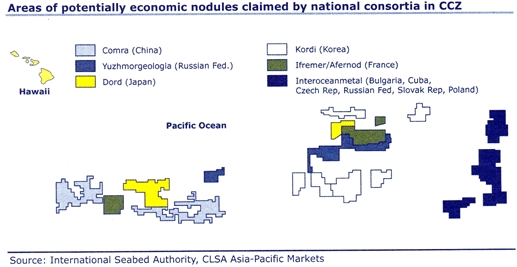
Fig 1 National Mine Site Claims in the CCZ
Also about this time, potentially economic nodule deposits were found in the central Indian Ocean and the SW Pacific. Hitherto, all attention had been focused in the CCZ, which recent resource estimates suggest contains about 7.5 billion tonnes of Mn, 340mt of Ni, 78mt of Co and 265mt of Cu.
General recognition of Exclusive Economic Zones (EEZs) as potential sites of deep-sea minerals dates from the early 1980s, and was given publicity by the declaration of a very large EEZ around the United States. Exclusive Economic Zones are areas within 200 miles of the coastal state in which that state exerts jurisdiction over resources. Areas beyond 200 miles come under the jurisdiction of the International Seabed Authority (ISA) of the United Nations. Since the 1980s, many nations have sought to exercise control over the seabed resources adjacent to their coasts.
In the 1960s there was a view that Britain could claim rights over large areas of mineral deposits in the western and southern Pacific by virtue of its colonial possessions. Of course that never happened because all but one those colonies became independent. These countries are now themselves at the forefront of EEZ mineral exploration! Interestingly, the only remaining British colony, Pitcairn Island, was found (in the 1990s) to possess hydrothermal minerals nearby, and this was used by HMG as justification for declaring an EEZ around it.
Circumspection
Between the mid-1980s and the turn of the Century, estimates of the resource potential of nodules were downgraded and the deep-sea mining that was widely expected to take place before the end of the 20th Century did not. There were several reasons. First, the oil price hike of the mid-1970s added greatly to the energy cost of processing nodules. Processing was considered the single most costly component in the utilisation of nodules at that time.
Second, the Law of the Sea Treaty (concluded 1982) contained some provisions with which some potential deep sea miners were not happy. By and large these difficulties were not resolved until the mid-90s. Third, increasing environmental awareness during the 1980s and 90s resulted in deep-sea mining no longer being regarded as a ‘pollution free’ option, but as a possible despoiler of the oceans, with all the financial burdens associated with that. Fourth, and probably most important, the prices of the major metals in the nodules - Mn, Ni, Cu & Co - remained stable or declined during the last 20 years of the 20th Century, with many land-based mines for these elements not working at full capacity - so removing one of the main economic drivers.
Cautious optimism
This commenced during the early part of the first decade of the 21st Century amid generally rising commodity prices <Fig 2>. The realisation dawned that several deep-sea hydrothermal mineral deposits discovered during the late 20th Century might be valuable sources of metals, in addition to those in the nodules. This led to the formation of several companies dedicated to mining hydrothermal deposits - although at time of writing none has actually been mined.
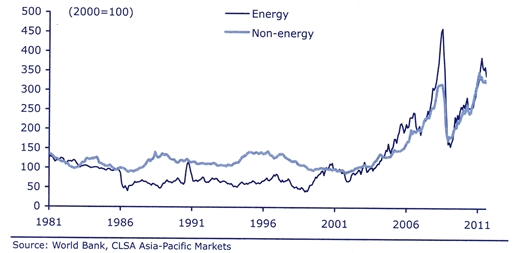 Fig 2 Commodity prices 1980-2011
Fig 2 Commodity prices 1980-2011
The most recent resurgence of interest is due not only to the recent rapid recovery in commodity prices but also to perceived future shortages caused by traditionally mineral-exporting countries like China requiring them to fuel their own industrial development, and even becoming large buyers on world markets. This is particularly the case with Rare Earth Elements (REE). If any one single group of elements can be held responsible for this resurgence of interest in polymetallic nodules, it is arguably the REE.
Polymetallic nodules
The abundance and distribution of nodules is very variable ocean-wide, and can also be highly variable on the scale of a kilometre, or less. Nevertheless, there are patterns in the distribution of nodules <Fig 3>, although it should always be borne in mind that areas of high overall abundance can always contain sparse pockets. Distribution depends on a number of processes, including the availability of nuclei on the sea floor and the nature, age and rate of accumulation of the underlying sediment. Low sedimentation rates favour high nodule abundance, either as a result of limited sediment supply or strong currents keeping the sediments in suspension.
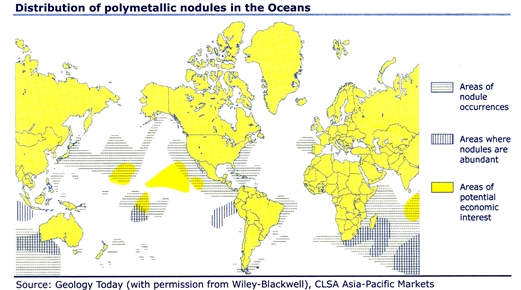 Fig 3 Distribution of Polymetallic Nodules in the Oceans
Fig 3 Distribution of Polymetallic Nodules in the Oceans
Nodules are abundant in the Pacific Ocean in the Clarion-Clipperton Zone, and further west in the Central Pacific Basin. In the South Pacific, distribution and abundance is more irregular than in the North Pacific largely because of greater topographic and sediment diversity. Nodules are most abundant in basins <Fig 4>. Those in the Penrhyn Basin largely occur in the EEZ of the Cook Islands and are of economic interest.
Potentially economic nodules in the Pacific generally follow the isolines of intermediate biological productivity, strongly suggestive of a biological control on composition. They all have features in common and are thought to have obtained their distinctive composition by similar processes6, but only in the CCZ, Peru Basin and Penrhyn Basin do they have high enough abundances to make them economically interesting.
High nodule concentrations have also been recorded in parts of the Central Indian Ocean Basin which is the area of greatest economic interest and the object of a site claim by the Government of India <Fig 5>. Nodule abundance in the Atlantic Ocean appears to be more limited than in the Pacific or Indian Oceans. No potentially economic deposits are known.
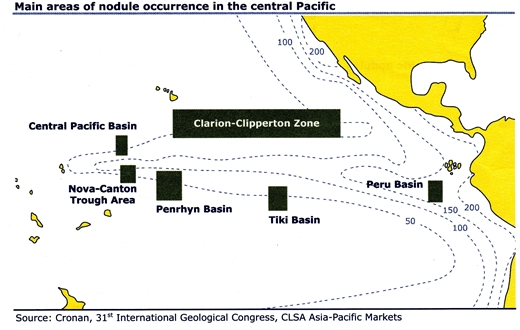 Fig 4 (left) Potentially economic nodule deposits in the Central Pacific and Peru Basin
Fig 4 (left) Potentially economic nodule deposits in the Central Pacific and Peru Basin
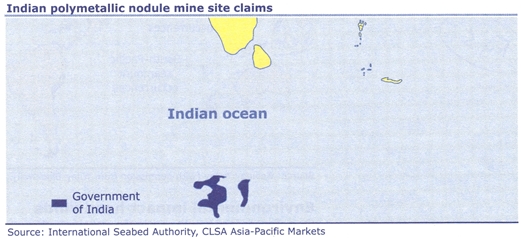 Fig 5 Potentially economic nodule deposits in the Indian Ocean
Fig 5 Potentially economic nodule deposits in the Indian Ocean
Compositional Variability
Polymetallic nodules exhibit a continuous compositional mixing from diagenetic end-members enriched in Mn, Ni and Cu, to hydrogenous end-members enriched in Fe and Co. The diagenetic deposits derive their metals at least in part from recycling, through sediment pore-waters, of elements originally contained in organic phases that have decayed and dissolved in the sediments. Hydrogenous deposits receive their metals from normal seawater or non-metal-enriched sediment porewaters.
Potentially ore-grade Ni and Cu-rich nodules of resource interest in the CCZ and Peru Basin fall near the diagenetic end-member in composition, and are enriched in these metals up to a maximum of about 3% combined, and contain up to 25% or more of Mn, but are relatively low in Co. By contrast, Co-rich nodules of resource interest in the Penrhyn Basin are hydrogenous and contain up to about 0.6% Co. The total amounts of Mn, Ni and Co in polymetallic nodules are thought to exceed terrestrial reserves of those elements. By contrast, the nodules are thought to contain only about 10% of known land reserves of Cu.
Nodules can show enrichment in many elements up to 100 times their crustal abundances <Table 1, below>.
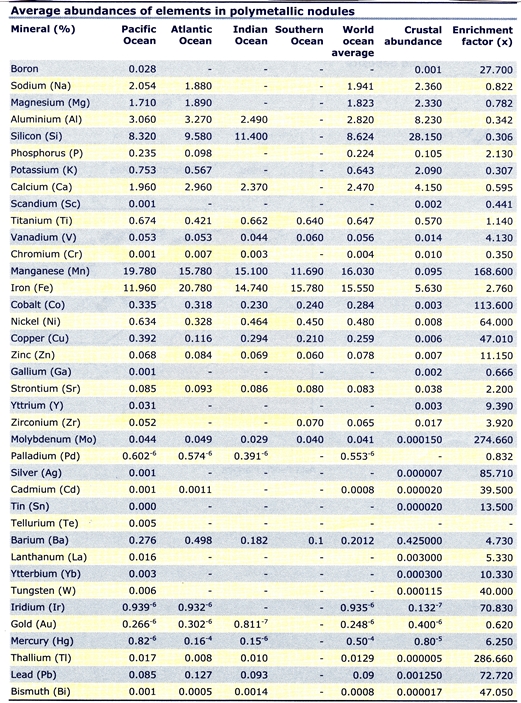
Currently, some of the rarer elements are of interest for technology purposes. Koschinsky et al.7 have mentioned not only the REE in this context, but Li, Te, Pt, V, Mo and W too. Nodules are unlikely to be mined principally for these elements, but their recovery could enhance the value of a nodule mining operation.
The importance of Mn to a nodule-mining operation has increased in recent years as steel production, particularly in developing countries, has become more important. In contrast, Co has a limited worldwide production. Only in EEZs in the Pacific is nodule mining principally for Co being actively considered.
Outlook
Now, in the second decade of the 21st Century, the outlook for nodule mining looks more positive than at any time in over 35 years. It is likely to commence in the International Seabed Area sometime during the next decade.
One of the most recent entrants to the Pacific nodule business, which perhaps indicates how future nodule developments in the CCZ may proceed, is Nauru Ocean Resources Inc., (NORI). NORI seeks to explore and possibly mine nodules in some of those areas that have been relinquished to the ISA by the National Consortia under Law of the Sea Treaty provisions. It has been granted (July 2011) exploration licences in four such areas <Fig 6>, which will be explored by its sub-contractor Deep Green Resources Inc. This opens up the possibility that other developing states, and possibly developed states too, will wish to work in relinquished ISA areas rather than their own.
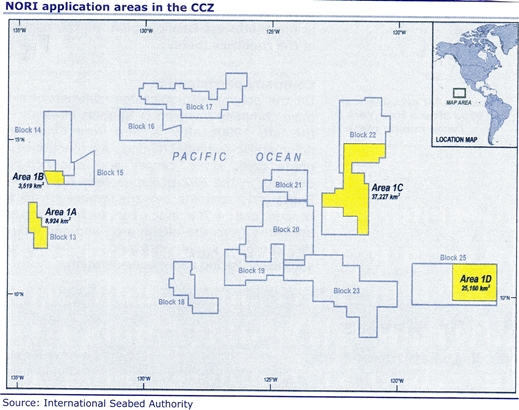
Fig 6 Nauru Ocean Resources Inc nodule exploration areas in the CCZ.
Hydrothermal deposits
Potentially economic deep-sea hydrothermal mineral deposits consist of sulphides of Fe, Cu and Zn. Most of the occurrences reported lie along mid-ocean ridges, at volcanically active ocean margins and in the Red Sea. The last were originally thought to be an isolated hydrothermal occurrence, but were later realised to be a result of the hydrothermal activity that occurs all along the world mid-ocean ridge system8.
These deposits are formed as a result of seawater entering hot volcanic rocks through cracks and fissures, becoming heated, and leaching metals from those rocks - thereby becoming transformed into a mineralising brine. This then rises back to the sea floor to precipitate the leached metals, often as chimneys.
Mid-ocean ridges
Composition depends on several factors, including temperature, sub-seafloor rocks, and the amount of circulating heated seawater at the site of leaching. Small amounts of gold, silver and other valuable metals have been found in MOR sulphides - ranging from about 1-16ppm Au, and 100-640ppm Ag. High concentrations of Au are generally associated with elevated Pb, As and Sb concentrations in the deposits too.
Probably to be of serious resource potential, seafloor polymetallic sulphide deposits should contain precious metals. Some deposits are inactive. This is important to their resource potential because mining inactive deposits will be easier and less environmentally damaging than currently-active deposits, with their high temperatures and abundant fauna.
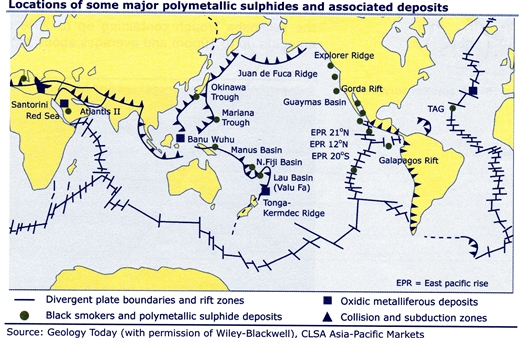 Fig 7 Locations of some major polymetallic sulphides and associated deposits.
Fig 7 Locations of some major polymetallic sulphides and associated deposits.
Ocean margins
Hydrothermal mineralisation can occur at volcanically active ocean margins like volcanic island arcs, back-arc basins and volcanic seamounts <Fig 8>. Back-arc basins are the most important. The origins of hydrothermal mineral deposits at ocean margins are more or less similar to those on mid-ocean ridges. However, whereas in the mid-ocean the rock being leached is predominantly basalt, a greater variety of rock-types is available at ocean margins, so creating greater variety of hydrothermal solution compositions and precipitates.
Fig 8 Settings of ocean margin hydrothermal mineral deposits.
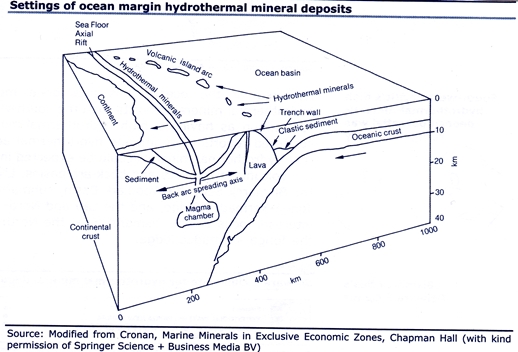 The best studied and most economically valuable ocean-margin hydrothermal mineral deposits discovered to date lie in the SW Pacific. Recent work in the Bismarck Sea has found many hydrothermal chimney-vent areas and hydrothermal polymetallic sulphides. One such is the Solwara 1 deposit, at 3.798S, 152.094E, about 50km from Rabaul <Fig 9>. The hydrothermal field containing Solwara 1 extends for five kilometres across two domes. It is composed of several sulphide deposits, over which fields of sulphide chimneys are developed.
The best studied and most economically valuable ocean-margin hydrothermal mineral deposits discovered to date lie in the SW Pacific. Recent work in the Bismarck Sea has found many hydrothermal chimney-vent areas and hydrothermal polymetallic sulphides. One such is the Solwara 1 deposit, at 3.798S, 152.094E, about 50km from Rabaul <Fig 9>. The hydrothermal field containing Solwara 1 extends for five kilometres across two domes. It is composed of several sulphide deposits, over which fields of sulphide chimneys are developed.
Where development is strongest, the chimneys merge into mounds. The Solwara 1 deposit contains base metal sulphides, Au and Ag. Nautilus Minerals Niugini has held exploration title over it since 2005. Estimates indicate that the deposit contains about 0.87mt of minerals of average grade 6.8% Cu, 0.4% Zn, 4.8g/t Au and 23g/t Ag. Production has been delayed but mining is expected within the next few years.
Fig 9. Solwara 1 claim site for hydrothermal mineral deposits in the Bismarck Sea.
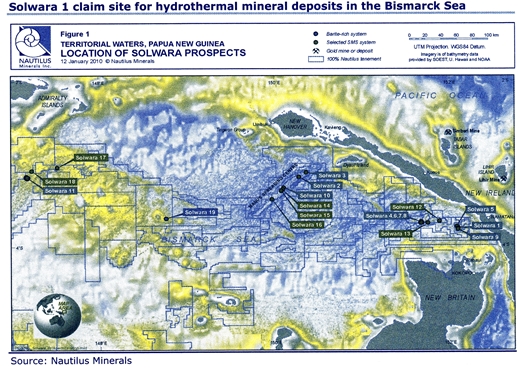
Future directions
Minerals markets have recently performed well overall, with increasing demand for mineral commodities and higher prices. This is particularly noteworthy in the case of groups of rare elements like the REE needed in the recently emerged technology industries. Renewed efforts to develop economic and technological solutions to the issues surrounding development of deep sea minerals is likely to continue.
Should the recent commodities boom continue for any length of time it can be expected that polymetallic sulphides in the SW Pacific will be brought into production in the near future. First will be Solwara 1. Should mineral commodity shortages continue, we can expect nodule mining to follow some years later, probably in the 2020s. Favoured early starters include Ni and Cu-rich nodule deposits in the CCZ, and Co rich nodule deposits the EEZ of the Cook Islands.
*David Cronan is Emeritus Professor of Marine Geochemistry at Imperial College London. He has written two books on marine minerals and is currently working on a third.
References
- Mero J L (1965) The Mineral Resources of the Sea. Elsevier, Amsterdam
- Glasby G P (1977) Historical Introduction. In Glasby G P (ed) Marine Manganese Deposits. Elsevier, Amsterdam 1-10.
- Dunham K C (1964) Neptunist concepts in ore genesis. Econ Geol, 59, 1-21.
- Heydon R (2012) Meeting global and environmental and social development objectives through sustainable seafloor resources. Abs. Underwater Mining Institute, 2012
- See http://www.grida.no/publications/deep-sea-minerals/
- Cronan D S (2006) Processes in the formation of central Pacific manganese nodule deposits (ImarEST London) J.Mar.Sci.& Env.C4:41-47.
- Koschinsky A, Alexander B, Bau M ,Hein J, & Schmidt K (2010) Rare and valuable metals for high-tech applications found in marine ferromanganese nodules and crusts: relationships to genetic endmembers. Abs. Underwater mining Institute 2010.
- Cronan D S (1976) Implications of metal dispersion from submarine hydrothermal systems for mineral exploration on mid-ocean ridges and in island arcs. Nature, 262:567-569.